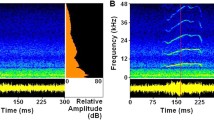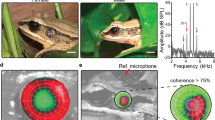Abstract
The concave-eared torrent frogs (Amolops tormotus) have highly unusual ear morphology—in males the eardrums are embedded deep inside ear cavities. In collaboration with our colleagues we investigated the functional significance of this morphological feature in hearing. Sound recordings in the field showed that males of A. tormotus produce diverse bird-like melodic calls with pronounced frequency modulations and non-linear phenomena (e.g., frequency jumps, different orders of subharmonics, and chaos) that often contain spectral energy in the ultrasonic range. The audible as well as the ultrasonic components of the species call could effectively evoke males’ vocal responses, demonstrating that they can hear and respond to ultrasound. Electrophysiological recordings from the auditory midbrain confirmed the ultrasonic hearing capacity of these frogs. The recessed tympana and extremely thin tympanic membranes are adaptations for hearing ultrasound—this sensitivity may have evolved in response to the intense, predominately low-frequency ambient noise from local streams. Finally, results from the isolated laryngeal preparation in euthanized frogs revealed that the origin of call complexity and diversity lies with having a vocal system with nonlinear properties.







Similar content being viewed by others
Abbreviations
- AEP:
-
Average evoked potential
- AUD:
-
Audible components
- CF:
-
Constant-frequency
- FM:
-
Frequency-modulated
- SPL:
-
Sound pressure level
- US:
-
Ultrasonic components
References
Anson M, Pinder AC, Keating MJ, Chung SH (1985) Acoustic vibration of the amphibian eardrum studied by white noise analysis and holographic interferometry. J Acoust Soc Am 78:916–923
Bogert CM (1960) The influence of sound on the behavior of amphibians and reptiles. In: Lanyon WE, Tavolga WN (eds) Animal sounds and communication. AIBS, Washington DC, pp 137–320
Bradbury JW, Vehrencamp SL (1998) Principles of animal communication. Sinauer Associates, Sunderland
Chen BH (1991) The amphibian and reptilian fauna of Anhui. Anhui Publishing House of Science and Technology, Hefei
Christensen-Dalsgaard J, Ludwig TA, Narins PM (2002) Call diversity in an old world treefrog: level dependence and latency of acoustic responses. Bioacoustics 13:21–35
Corso JF (1963) Bone-conduction thresholds for sonic and ultrasonic frequencies. J Acoust Soc Am 35:1738–1743
Dieroof HG, Ertel H (1975) Some thoughts on the perception of ultrasonics by man. Arch Otorhinolaryngol 209:277–290
Dubois A (1992) Notes sur la classification des Ranidae (Amphibiens Anoures). Bull Mens Soc Linn Lyon 61:305–352
Fee MS (2002) Measurement of the linear and nonlinear mechanical properties of the oscine syrinx. J Comp Physiol A188:829–839
Fee MS, Shraiman B, Pesaran B, Mitra PP (1998) The role of nonlinear dynamics of the syrinx in the vocalizations of a songbird. Nature 395:67–71
Feng AS, Narins PM, Xu CH (2002) Vocal acrobatics in a Chinese frog, Amolops tormotus. Naturwissenschaften 89:352–356
Feng AS, Narins PM, Xu CH, Lin WY, Yu ZL, Qiu Q, Xu ZM, Shen JX (2006) Ultrasonic communication in frogs. Nature 440:333–336
Fitch WT, Neubauer J, Herzel H (2002) Calls out of chaos: the adaptive significance of nonlinear phenomena in mammalian vocal production. Anim Behav 63:407–418
Gridi-Papp M, Rand AS, Ryan MJ (2006) Animal communication: complex call production in the tungara frog. Nature 441:38
Hauser MD (1996) The evolution of communication. MIT, Cambridge
Herzel H, Berry D, Titze I, Steinecke I (1995) Nonlinear dynamics of the voice: signal analysis and biomechanical modeling. Chaos 5:30–34
Hosoi H, Imaizumi S, Sakaguchi T, Tonoike M, Murata K (1998) Activation of the auditory cortex by ultrasound. Lancet 351:496–497
Huang MH (1991) Fauna of Zhejiang: Amphibia, reptilia. Zhejiang Science and Technology Publishing House, Hangzhou
Imaizumi S, Hosoi H, Sakaguchi T, Watanabe Y, Sadato N, Nakamura S, Waki A, Yonekura Y (2001) Ultrasound activates the auditory cortex of profoundly deaf subjects. Neuroreport 12:583–586
Inger RF (1966) The systematics and zoogeography of the amphibian of Borneo. Fieldiana: Zool 52:1–402
Jørgensen MB, Kanneworff M (1998) Middle ear transmission in the grass frog, Rana temporaria. J Comp Physiol 182:59–64
Liu WZ, Yang DT, Ferraris C, Matsui M (2000) Amolops bellulus: a new species of stream-breeding frog from western Yunnan, China (Anura: Ranidae). Copeia 2000(2):536–541
Manley GA (1972) The middle ear of the Tokay gecko. J Comp Physiol 81:239–250
Manley GA (1990) Peripheral hearing mechanisms in reptiles and birds. Springer, New York
Mason MJ, Narins PM (2002a) Vibrometric studies of the middle ear of the bullfrog Rana catesbeiana I. The extrastapes. J Exp Biol 205:3153–3165
Mason MJ, Narins PM (2002b) Vibrometric studies of the middle ear of the bullfrog Rana catesbeiana II. The operculum. J Exp Biol 205:3167–3176
Matsui M (1986) Three new species of Amolops from Borneo. Copeia 1986:623–630
Matsui M, Nabhitabhata J (2006) A new species of Amolops from Thailand (Amphibia, Anura, Ranidae). Zool Sci 23:727–732
Matsui M, Wu GF, Yong HS (1993) Acoustic characteristics of three species of the genus Amolops (Amphibia, Anura, Ranidae). Zool Sci 10:691–695
Matsui M, Shimada T, Liu WZ, Maryati M, Khonsue W, Orlov N (2006) Phylogenetic relationships of oriental torrent frogs in the genus Amolops and its allies (Amphibia, Anura, Ranidae). Molec Phylogenet Evol 38:659–666
Narins PM, Feng AS, Yong HS, Christensen-Dalsgaard J (1998) Morphological, behavioral and genetic divergence of sympatric morphotypes of the treefrog Polypedetes leucomystax in peninsular Malaysia. Herpetol 54:129–142
Narins PM, Lewis ER, McClelland BE (2000) Hyperextended call note repertoire of the endemic Madasgascar treefrog Boophis madagascariensis (Rhacophoridae). J Zool (Lond) 250:283–298
Narins PM, Feng AS, Lin WY, Schnitzler HU, Denzinger A, Suthers RA, Xu CH (2004) Old world frog and bird vocalizations contain prominent ultrasonic harmonics. J Acoust Soc Am 115:910–913
Penna M, Veloso A (1990) Vocal diversity in frogs of the South American temperate forest. J Herpetol 24:23–33
Pumphrey RJ 1950) Upper limit of frequency for human hearing. Nature 166:571
Purgue AP (1997) Tympanic sound radiation in the bullfrog Rana catesbeiana. J Comp Physiol A181:438–445
Rand AS (1988) An overview of anuran acoustic communication. In: Fritzsch B, Ryan MJ, Wilczynski W, Hetherington TE, Walkowiak W (eds) The evolution of the amphibian auditory system. Wiley, New York, pp 415–431
Sales G, Pye D (1974) Ultrasonic communication by animals. Chapman and Hall, London
Schmid E (1978) Contribution to the morphology and histology of the vocal cords of Central European anurans (Amphibia). Zool Jahrb Abt Anat Ontogenie Tiere 99:133–150
Slabbekoorn H, Peet M (2003) Birds sing at a higher pitch in urban noise. Nature 424:267
Sundberg J (1987) The science of the singing voice. Northern Illinois University Press, Dekalb
Suthers RA, Narins PM, Lin WY, Schnitzler HU, Denzinger A, Xu CH, Feng AS (2006) Voices of the dead: complex nonlinear vocal signals from the larynx of an ultrasonic frog. J Exp Biol 209:4984–4993
Wilden I, Herzel H, Peters G, Tembrock G (1998) Subharmonics, biphonation, and deterministic chaos in mammal vocalizations. Bioacoustics 9:171–196
Wu GF (1977) A new species of frog from Huang-Shan, Anhui, Rana tormotus Wu. Acta Zool Sinica, Beijing 23:113–115
Yang DT (1991) Phylogenetic systematics of the Amolops group of ranid frogs of Southeastern Asia and the greater Sunda Islands. Fieldiana: Zool 63:1–42
Zhao EM, Adler K (1993) Herpetology of China. Society for the Study of Amphibians and Reptiles, Oxford
Acknowledgments
The Chinese Academy of Science sponsored the fieldwork. This research involved extensive collaborations with Annette Denzinger, Wenyu Lin, Qiang Qiu, Hans-Ulrich Schnitzler, Roderick Suthers, Zhimin Xu, Zulin Yu, and foremost Chun-He Xu and Jun-Xian Shen. Kraig Adler informed us of the unusual auditory apparatus of this species. Professor Chen-Me Tsai, Qilin Chen, Weng Jun, Yong Yu, Xinjian Yu, and Yunglung Zhou provided invaluable assistance with the fieldwork. The research is supported by grants from the National Institute for Deafness and Other Communication Disorders of the NIH (R01DC04998 to ASF and R01DC00222 to PMN) and a grant of the National Science Foundation (CNCRS-0422073) to ASF.
Author information
Authors and Affiliations
Corresponding author
Additional information
A manuscript for a special issue of JCP-A, Comparative Neurobiology: Papers in memory of Theodore H. Bullock.
Rights and permissions
About this article
Cite this article
Feng, A.S., Narins, P.M. Ultrasonic communication in concave-eared torrent frogs (Amolops tormotus). J Comp Physiol A 194, 159–167 (2008). https://doi.org/10.1007/s00359-007-0267-1
Received:
Revised:
Accepted:
Published:
Issue Date:
DOI: https://doi.org/10.1007/s00359-007-0267-1




